In this article, I am going to give you the exact hockey training blueprint to follow so that you tackle this off-season in the most efficient and productive way that you possibly can which will have you entering the next season a completely different hockey player.
In order to design an effective off-season hockey training program for hockey players, it’s vital that you understand the specific demands that these athletes are exposed to throughout their entire competitive season so that you can prioritize what you need to do and when it needs to be done by.
If you don’t, you won’t know where to start in order to start remedying the issues and optimizing the specific needs that are going to allow them to improve their functional outputs where it counts most… out on the ice.
Having a working understanding of hockey-specific active recovery, structural imbalances, mobility restrictions, GPP, SPP, energy system integration, and periodization will allow you to structure your phases in a way that guarantees improved performance outputs in the next season.
I know that might sound like a lot, and that’s because it is a lot.
When you think about a hockey player, they really need to be a “catch-all” type of athlete from a physical perspective because in order to be an all-star you need to have:
- Total body strength
- Aerobic endurance
- Anaerobic endurance
- Explosive power
- High-level agility
- Flawless coordination
- Complete balance
- Excellent mobility
And many other things as well which makes their training structure much more complex than their one-dimensional counterparts (e.g. marathon running or shotput where only a couple of things need to be worked on).
A good hockey coach doesn’t just sit down and write a program.
Instead, they turn periodization (which is the logical structure and sequencing of your training phases) into a game of reverse-engineering.
They ask themselves:
Ok, if I know I need to have my hockey improve in ALL of those areas before the next season — how can I work backward from that endpoint in order to guarantee my success with this program design?
Let’s answer that question together throughout this article as we analyze the primary problems hockey players endure and then work to find solutions for every area of optimizing hockey performance.
Why Your Training Needs To Be Periodized
First on deck is the importance of properly scheduling and sequencing your training phases.
Although this particular article is largely about how to start your off-season, it wouldn’t be a complete article if I didn’t mention how you need to start your off-season with the end in mind.
The answer to reverse engineering your program design lies directly within the structure of the entire off-season as a whole rather than the sum of its parts.
You can think about it as an orchestra.
A composer does an excellent job of creating a vision for how to create the music he hears in his head and bring it to real life in one beautiful harmony.
Along the way, he must change the timing of when certain instruments are used, the tune he wants them to play in, which instruments play well together and which don’t, and how to create a finale where the performance peaks and they leave the stage with a bang.
Additionally, the composer has the thankless job of completely removing those who don’t play well by themselves or with others, no matter how well-meaning they may have been.
This is exactly like hockey training periodization.
A coach creates a vision to create the complete hockey player from every angle and needs to “orchestrate” the goals for each progressive phase and how he is going to achieve a hockey-specific result through manipulating the volume, intensity, and frequency of each training week while eliminating the “noise” that doesn’t belong.
This is the big difference between training and exercising.
Exercising is just burning calories, whereas training is a controlled system guaranteed to produce hockey-specific results.
Unfortunately, most hockey players just exercise.
Although that’s not the biggest problem.
The real issue is the fact that they think their exercise is real training because they are doing hockey specific movements in their workouts.
Wrong.
A workout is more than just a collection of exercises.
A program is more than just a collection of workouts.
And periodization is more than just a collection of programs.
They must all be orchestrated in the correct order and exactly the right time in order to produce the “vision” that you have created in your head to produce all-around improvements in hockey performance.
Programs and workouts must always build upon each other in an objective way throughout the off-season based on the sports science research behind important concepts such as speed development, functional strength, improving conditioning and maximizing agility.
When you just “do hockey workouts” from YouTube, magazines or social media you are deceiving yourself to thinking that you’re on a hockey training program when in reality you’re on a hockey exercising program that lacks direction, intention, and measurable progressive overload.
Here are the primary phase goals I like to set for each phase of the off-season.
REGENERATION PHASE:
- Optional athlete assessment profile
- Active recovery post-playoffs
- Improve mobility restrictions
- Improve structural imbalances
- Improve strength imbalances
PHASE 1: General Physical Preparedness (GPP)
- Emphasize total body strength and hypertrophy gains
- Develop an aerobic conditioning base
- Improve mobility restrictions
- Improve structural imbalances
- Improve strength imbalances
PHASE 2: GPP
- Emphasize total body strength and hypertrophy gains
- Develop an aerobic conditioning base
- Introduce anaerobic conditioning work
- Improve mobility restrictions
- Improve structural imbalances
- Improve strength imbalances
PHASE 3: GPP/SPP HYBRID
- Emphasize total body strength and power output
- Maximize aerobic conditioning base
- Amplify anaerobic conditioning work
- Introduce speed training
- At this point, mobility/structural/strength imbalance issues have been fixed
- Introduce SPP component to training to convert “gym strength” into functional hockey strength
PHASE 4: SPP (Specific Physical Preparedness)
- Emphasize total body strength and power output
- Introduce power-endurance component
- Maximize anaerobic conditioning work
- Maximize speed training
- Maximize SPP component to training to convert “gym strength” into functional hockey strength
- Introduce mental and physical agility programming
- At this point, the aerobic conditioning base is strong enough as to back off the training volume prescription in this department to allow more volume to be placed on hockey-specific conditioning, speed, and agility programming
PHASE 5: SPP
- Maximize total body power endurance
- Maximize anaerobic conditioning
- Maximize speed training
- Maximize mental and physical agility programming
- Maximize SPP outputs
PHASE 6: TAPER AND PEAK
- Peak total body power endurance
- Peak anaerobic conditioning
- Peak speed training
- Peak mental and physical agility programming
- Peak SPP outputs
- Athletes undergo a brief training volume tapering period in order to peak their hockey-specific performance and enter the next season a completely different hockey player
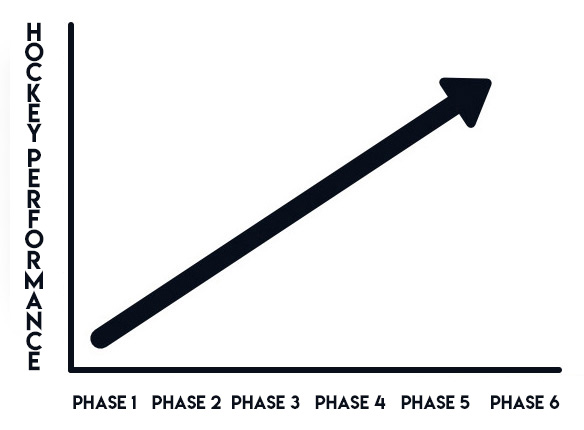
*Each phase builds upon the last in an objective way in which you can both see and feel your performance outputs increasing
**Introduce deloads where necessary based on your volume, intensity, and frequency prescriptions
Hockey Assessments and Testing
Within the regeneration phase of the off-season programming is where I like to incorporate personalized testing and assessments of hockey athletes.
This is a service I personally offer the members of the Hockey Skills Accelerator, but long story short, you are looking for the weakest link in the chain.
A great coach doesn’t just support what you’re already good at, rather, a great coach focuses on bringing up your most glaring weaknesses which are holding you back from reaching your true potential out on the ice.
Here’s the problem — the human body is the ultimate compensation machine.
Meaning, anytime you have a weakness your body does an excellent job of “hiding it” through forcing another muscle group to pick up the slack.
For example, if you have really tight hamstrings, this is usually a compensation mechanism that the body uses to make up for the fact that you have weak glutes and a weak core that fail to properly stabilize the pelvis (so your body adds stability in a non-functional way by tightening itself up).
Another example could easily be seen by the athletes out there who have an overly dominant take-off leg that they always use to explode with.
Your body knows the one side is more explosive so you naturally rely on it every time, but, this ultimately slows you down out on the ice because you will save much more time if you are explosive with both legs rather than just one.
So, what do we do?
We create tests that make compensation mechanisms extremely noticeable so that you can identify the weak link in the chain and therefore prioritize that throughout your off-season to plug the leaks in your performance output.

Every coach has a different way of approaching this, but I personally like to use simple bodyweight exercise tests to analyze structural imbalances, strength imbalances, mobility restrictions, stability/instability of working structures, and balance/coordination.
From those alone, we can collect a ton of data. The only problem here is that it requires an educated coach’s eye to really identify what the issue is and how you’re going to remedy it — that why I do the assessments myself in the Skills Accelerator and offer real-time feedback on the athlete.
But, I also created a less-advanced series of assessments that you can conduct completely by yourself utilizing the High-Performance Hockey Testing Program (included in our off-season programs) which is utilized for aerobic conditioning, anaerobic conditioning, peak power outputs, upper/lower body functional strength testing, among many other useful tools.
The big lesson here though is that you don’t want to fly blind.
Identifying your weaknesses is the first step towards remedying them so that you become a more complete hockey player.
If you never find your weaknesses you will never know what’s holding you back, so in a major way, you can consider assessment testing as the ultimate hockey training plateau buster because it gives you the exact answer you need in order to prioritize your training volume.
Active Recovery Post-Season
As the research continues to come out in sports science, we are beginning to find that active recovery methods are actually superior to doing nothing at all.
Meaning, if you want to recover faster, then it’s beneficial for you to partake in a low-intensity activity on your off-days from training (as opposed to just sitting there and playing video games).
It’s counter-intuitive thinking because most people expect that being as lazy as possible allows the body to recover faster, but, light activity improves blood flow to the muscular system and creates a type of “flushing effect” within your sore and damaged muscles.
It helps bring the fatigue by-products out while simultaneously deliver glucose and amino acids to support accelerated repair processes.
Yoga, light swimming, or just simply going for a hike all work very well here.
But, I personally like to utilize the “regeneration phase” I talked about above to act as a post-playoffs active recovery phase.
It’s designed in a way that facilitates accelerated recovery from the in-season/playoffs because it is low in overall training volume and light in terms of its intensity prescription — but at the same time, I prefer it over other activities (such as the ones listed above) because I can be more specific to the exact needs of a hockey player.
For example, hockey players have notoriously tight hips post-season — instead of having them go on a hike I could have them perform a couple of mobility circuits throughout the week to create the flushing effect that we are after but also unlock their hips while we’re at it.
Two birds with one stone and no time will this be more effective than right at the beginning of the off-season.
Now, think about using this active recovery phase to work on the multitude of issues hockey athletes have post-playoffs/season, it’s really more like 10 birds with one stone.
It also creates a “slingshot effect” going into phase one of the off-season programming.
Let’s say we had two hockey players and both players were subjected to the exact same stressors during a tough season.
One player decides to go on vacation for two weeks, sit by the beach, and then come home and jump right into phase one.
Whereas the other player decides to utilize this two week period for hockey-specific active recovery and works to correct his mobility restrictions.
The player who went on vacation won’t be as recovered as the one who stayed due to active recovery being more effective, and beyond this, the player who stayed and did a regeneration phase will also be entering the first phase of the off-season without any major mobility restrictions.
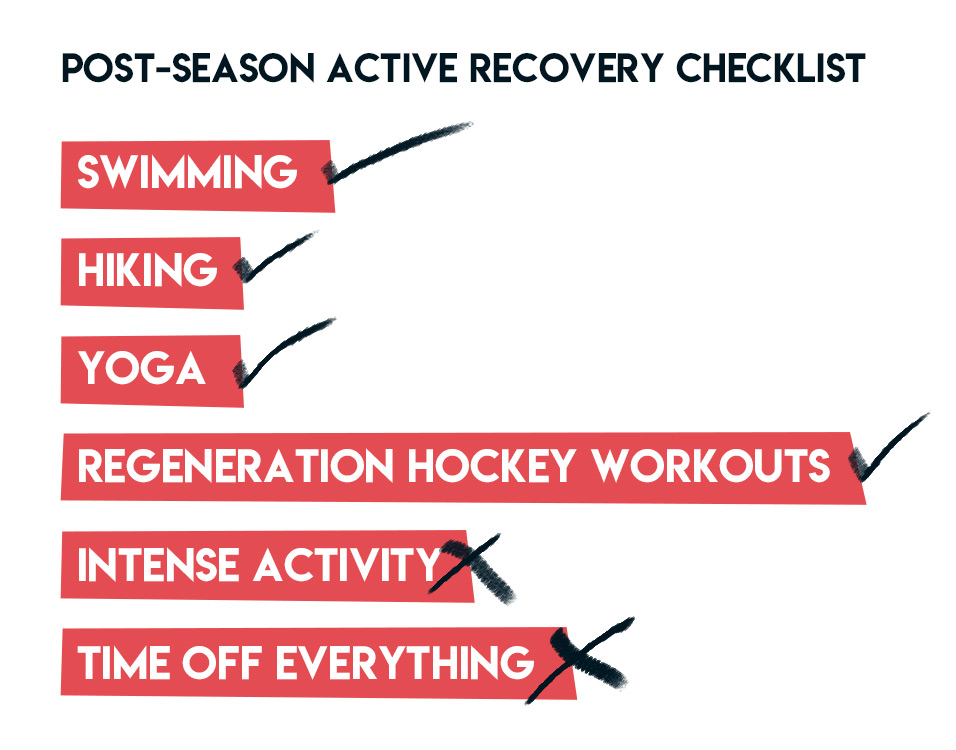
This is very important to care about because the player who went on vacation will come back and jump right into movements such as barbell back squats even though he has tightness, instability, and structural issues all over his body.
This puts him at a much greater risk of injury because he is choosing exercises that he is not ready for yet. I always say, “If you can’t do it, don’t load it!” — Meaning, if you have restrictions holding back your movement patterns stay away from loading those movement patterns with a barbell because you’re only going to reinforce bad technique and increase your risk for injury.
Meanwhile, the athlete with the regeneration phase under his belt won’t have the same issues because he primed himself to take on a harder phase of programming.
He has no physical restrictions and will be able to train at a higher level come time for phase 1, therefore, “slingshotting” himself into having a much more productive off-season.
Correcting Hockey Mobility Issues
Mobility as an overall category has become something that goes in and out of trend rather than become a timeless staple in hockey training program design.
The strength and conditioning industry is funny that way, it goes back and forth on things all of the time (usually because hockey businesses would rather promote what they think is going to sell best rather than what they think is going to produce the best results).
Every time you hop on social media you’ll read something different.
This is why you HAVE to stretch 2 hours a day.
Stretching ruins your performance and you will never be good at hockey.
Mobility and stability are the ONLY things you should focus on.
Mobility and stability are overrated, just lift weights and skate.
Of course, nutrition coaches make the problem even worse by confusing the crap out of anyone who wants to improve their diet and they pre/post-game eating habits.
This industry is a tough one to tackle sometimes, but here at Hockey Training, we do our best to only provide you the facts based on real sports science.
Like always, in the department of strength and conditioning as a whole, the truth is found somewhere in the middle.
You find the truth when reviewing real data, and not while watching documentaries or listening to “that jacked guy from the gym”
I think something that has caused mobility to go back and forth in its perceived importance in this industry is the overall lack of a definition behind it.
It’s kind of a tough thing to define, isn’t it?
Everybody seems to have a different definition of the word mobility, and when asked most people will just say something very simple such as:
“Well, it’s like flexibility, right?”
Beyond this, everybody seems to have a different idea of what mobility should represent.
There are people out there who make money based on mobility work alone, so they want you to think that everybody should be as mobile as a gymnast – when in many cases the stuff they want you to do will have no impact on your on-ice performance at all.
Like everything in training, you eventually reach a point of diminishing returns. Just like it’s not beneficial for hockey players to be as big as bodybuilders it’s equally not beneficial for them to become contortionists.
In order for us to use mobility training to correctly improve hockey performance, we need to have a working understanding of what exactly it is and how it’s going to improve performance through dryland training.
When you break down mobility to identify it for what it truly is, it is the intersection of three different qualities:
- Flexibility
- Technique
- Strength
Flexibility is a part of the equation because you need to have the proper flexibility in order to perform the joint/muscle’s full range of motion through a given task.
Therefore, if you have flexibility issues it can either positively or negatively affect your mobility due to your lack of ability to achieve the full range of motion for the intended movement and/or muscle group.
Technique is a part of the equation because a person’s technical skill may be poor enough as to present itself as an issue of mobility.
For example, many people when in the hole of a squat (below parallel) tend to also bend over at the upper body and come out of the hole kind of in a squat/good morning motion – like they are doing both movements at the same time.
Coaches who exclusively make their money from mobility work will jump all over this and look for tightness in the posterior chain when all the client might need is some proper technical coaching to brace the core, distribute the weight evenly on the feet, and posture up.
Lastly, strength plays a large role in the topic/definition of mobility because it is strength that is allowing you to remain stable throughout a range of motion.
If you’re not strong enough to keep a fully postured back throughout the range of motion of a deep squat then that is a strength issue, not a flexibility or technique issue.
In another example, if you can’t lie on your back, extend your legs perpendicular with the ground and touch your toes this may be a weakness in the abdominals in order to bring your upper body up off the ground – and not tightness in the back preventing you from moving through that range of motion.
All three play an equal role in, what I would consider an umbrella term (since it covers multiple categories in one word), hockey mobility.

So, as we make our way through the rest of this guide, keep in mind the triangle of mobility (flexibility, technique, strength) and ensure that you are challenging your own thought process to identify where the real mobility issues in your life preside.
The worst thing that you would want to happen is to put hours, months, or even years of your effort into the wrong section of your mobility problem and find out the root cause of your issue was found within a completely different category of mobility enhancement.
Put another way, if your foam rolling and flexibility routine hasn’t worked for the 100th time in a row now, why do you think it’s going to work any different on the 101st?
Find your issue and make a plan to resolve that issue.
The definition of insanity is to repeat the same thing over and over but expect a different result.
Due to the biomechanics of skating and the fact that hockey is a unilateral sport, the primary issues that consistently pop up in every hockey player after the playoffs/in-season are:
- Tight hips/hip flexors
- Tight Achilles tendon and calves
- Tight vastus lateralis
- Tight hamstrings (specifically the biceps femoris)
- Tight lower back
- Tight shoulders
There are many ways to tackle these hockey-specific issues, but here is an example of a total body mobility routine that should give you excellent insight as to how I approach hockey-specific mobility within the Regeneration Phase:
1. Hang from pull-up bar: 1 x 1-2 minutes
2. Arm circles: 1 x 10/direction
3. Rotational arm swing: 1 x 8/side
4. Hip circles: 1 x 10/direction
5. Zombie squat with reach through: 1 x 10
6. Scorpion kicks: 1 x 8/side
**Note the particular muscle groups involved in these movements. I simplified things above by categorically saying things such as “hips” or “shoulders” even though they contain many different muscles
Naturally, as the off-season progresses so to would that volume of mobility work and exercise selection.
Correcting Structural Imbalance Issues In Hockey Players
Structural imbalances, from a skeletal muscle perspective (and not referring to bone or cartilage structure), can be found in the muscles through structural balance testing which is the hallmark of importance for the assessments I do for the hockey players within the Skills Accelerator.
When I have hockey athletes perform certain movements during the testing it exposes the structural differences and/or compensations because the movements are designed in a way where there is nowhere to hide.
Ideally, the perfect hockey athlete would be structurally balanced from the upper body to the lower body, and from the left side to the right side.
Depending on which tests you use; whether with added resistance, bodyweight-only, or locomotion-based — they will all tell you something about what is going on from a structural balance perspective.
There are many more tests available today that you can look at, but I personally like my own because I think a lot of people get lost in testing for physiotherapeutic purposes than for true performance purposes.
I don’t want the hockey player going through my programs to just be injury-free, rather, I want them to be injury-free and insanely good hockey players.
The purpose of a structural balance test, in my mind, is to put the hockey athletes through certain movement patterns in order to expose potential flaws in movement quality or structural integrity.
You want to be able to meet the strength/force output of one part of your body with an equal and opposite strength/force output of another part of your body to drive optimal movement.
This is what “balance” is all about.
If you aren’t balanced you will always be sacrificing optimal performance because no matter how strong or mobile you are, your movement mechanics will be altered in a way that will negatively impact your technique out on the ice.
When your movement mechanics and technique are thrown off you lose speed, athleticism, explosiveness, strength, and you also move with less efficiency which leads to quicker fatigue.
If you’re not balanced you’re not moving correctly because the structures and limbs responsible for counteracting another muscle can’t do their job appropriately.
When this happens, you start the domino effect that knocks down all categories of performance a certain percentage of what you could have otherwise accomplished had you been a balanced athlete.
Your true ability will only ever be “unlocked” once you balance the physical qualities you possess.
This is important to care about because structural imbalances completely plague the hockey world.
From a strength perspective, hockey players primarily have imbalances in the hamstrings, rotator cuffs, quadriceps, and core.
The way in which hockey players move and which muscles they primarily activate drives these imbalances over the course of a competitive season.
From a strength coach’s perspective, working with hockey players is constantly correcting strength imbalances due to the unilateral nature of the sport.
When looking for reasons why hockey athletes have structural imbalance issues, the trained eye doesn’t have to look so far.
In an easy example, if you look at a hockey player, he/she is bent over at the waist for pretty much the entire duration of a game or practice.
This shortens and tightens the hip flexors which can then lead to a whole host of postural issues including pain in the hips during movement (negatively affecting explosiveness), tightness in the hips overall (negatively affecting speed and agility), rounded shoulders (causing reduced shot power), shoulder impingement (causing shoulder pain), and a forward neck lean (at much greater risk for a neck injury if you play in a league that allows contact).
This is just one example of a cascade of events that kicks off with hockey players who don’t take their structural work seriously, or worse, for the hockey players out there whose coaches have never even heard of structural integrity work or who employ no structural balance testing at all prior to the off-season.
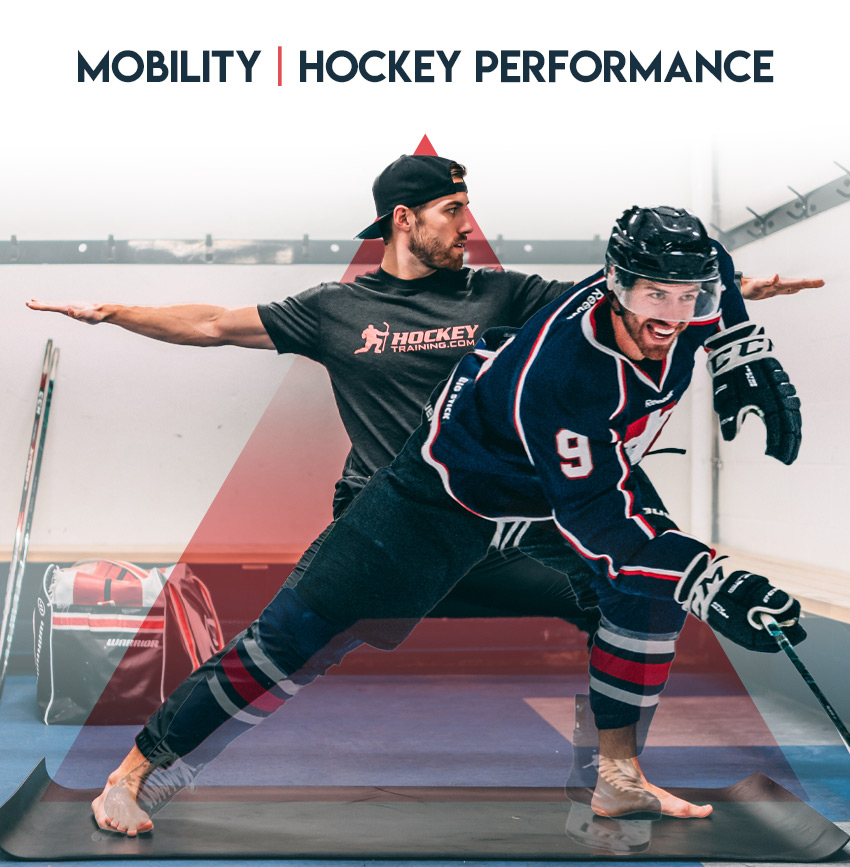
During the hockey season, proper training (which would otherwise reduce the degree of the structural issues) often gets pushed back due to accumulating fatigue, travel, and scheduling issues — and this is exactly why structural balance work is a major priority in the early training phases of the off-season.
Within this first phase, I like to correct the most common structural balance issues run into which are found within the following muscle groups:
- Vastus Medialis Oblique: Requires both strength and hypertrophy due to an overdeveloped vastus lateralis from the force vector of skating
- Semitendinosus and Semimembranosus: Two muscle groups found within hamstrings that become underdeveloped due to the articulation of the ankle during a skating stride
- Rotator Cuff: Requires external rotation strength and mobility due to an in-season of being internally rotated/contracted for an imbalanced amount of time
- Core: Requires both rotational strength and anti-rotational strength to be balanced out due to the core only needing to be strong/stable on one side from the unilateral aspect of the hockey shot
These strength differences in combination with correcting the mobility issues found within the previous section are the two true pillars of how a proper regeneration phase should be structured as the first thing you do post-season.
Transitioning From GPP To SPP To Ensure You Enter The Season Ready To Go
General Physical Preparedness (GPP) is intended to provide balanced physical conditioning in endurance, strength, speed, mobility, and other basic factors of athleticism, whereas Specific Physical Preparedness (SPP) concentrates on exercises which are more specific to the particular angles and velocity that you would expect to be exposed to during an on-ice game of hockey.
For example, building up hockey players from the ground up with their GPP is nearly identical from one athlete to the next.
They need to get strong, they need to get bigger, they need to have some mobility, they need to be structurally balanced, and they should have a well-balanced approach to conditioning including aerobic, lactic, and alactic workouts.
This builds up what you could refer to as GPP, or, general fitness.
Once you have a good level of general fitness, now is the time to focus on the more specific outputs in hockey that transfer you from having a good hockey training program into having a great hockey training program.
For example, an accurate representation of SPP would be optimizing the specific stride length and stride frequency for your speed out on the ice.
Another example could be found in optimizing the explosive hip turning and shoulder flexion/extension for the slap shot.
Or, lower body vertical power production for your explosive “starting speed” out on the ice… but at this point, I think you’re getting the point.
In essence, GPP is an opportunity for individuals to participate in low-intensity movements that improve all-around athletic performance capability — whereas the transition from GPP into SPP near the end of the off-season targets that approach specifically to hockey.
This may include improving body composition by losing body fat or increasing functional lean body mass. Another benefit of using GPP is to teach basic concepts of hockey such as proper foot contact and correct foot and body positioning during different skill movements.
This will help the hockey athlete become more proficient when they perform their actual sporting movements out on the ice once the off-season is over.
You can think about GPP like a shotgun approach to athletic performance where you have a massive spread that hits a lot of different things, whereas SPP is more like a sniper rifle in that it hones in on only what’s most relevant to hockey players in terms of replicating exactly what they would be exposed to during an on-ice game setting.
SPP is a continuation of GPP, but with more of an intention on the actual sporting skills.
Once the individual has some experience within a system, more of the focus can be translated to SPP work as it allows the athlete to remain closer to the hockey performance physical characteristic qualities that you’re going to need out on the ice.
As stated plenty of times in my past articles and videos, from an energy system perspective, I like to utilize tempo runs for aerobic GPP development (see below from an example of tempo runs).
From there, I have analyzed the needs of hockey from a physiological, kinetic, and bioenergetic perspective to know what we need to do to ultimately work my way from GPP into SPP when the hockey athletes are ready for it.
At that point for SPP, I introduce speed, conditioning, and agility training that takes things up a notch in terms of specificity and intensity.

Example Regeneration Phase Schedule
Here’s an example schedule hockey players could run through during the regeneration phase at the start of their off-season to “slingshot” there progress and results for the rest of their off-season periodization:
MONDAY: Regeneration Workout A
TUESDAY: Mobility Circuit
WEDNESDAY: Regeneration Workout B
THURSDAY: Mobility Circuit
FRIDAY: Regeneration Workout C
SATURDAY: Off
SUNDAY: Off
This phase is typically done for one to two weeks and is performed at a very low training volume and low training intensity to facilitate the active recovery we discussed while still focusing on the hockey specific mobility and structural balance issues through GPP work in the mobility circuits and regeneration workouts.
Tempo runs are introduced into Phase 1 (which is immediately after the regeneration phase) and then the entire off-season follows a properly periodized and optimized transition from GPP into SPP and ultimately into a tapering and peaking phase to unlock your next level of performance.
The Solution
The above schedule and information can be utilized to create a great start to your off-season to improve your all-around hockey performance, but if you want a complete “done for you” solution, the all-new Off-Season Domination 2020 system was designed to take all of the guesswork out of it for you so you can take your game to the next level.
This complete system includes all six phases of an elite hockey training program that you can perform at any local gym (and comes with an entire bodyweight-only version for the days you can’t make it so you never run into any plateaus no matter what life throws at you).
Remember, if your hockey performance isn’t great right now, it’s not your fault.
Real progress comes from real hockey specific training and this type of programming only comes from a hockey performance specialist.
You can’t find hockey-specific results in a non-hockey-specific program, and this is something rarely talked about in the hockey world.
Most people just exercise, yet, after going through this article you can start to see how “exercising” makes up a very small portion of what true training you should be doing.
The days of guessing and hoping you will be a better hockey player are over – get instant access to the Off-Season Domination program here so you can leave fans, coaches and scouts jaws on the floor with how much progress you have made in a single off-season.
Final Thoughts
Today, I hope I was able to articulate the unique design of true off-season hockey specific training and how much importance lies within your periodization and scheduling structure for the “big picture” of all six phases and not just the individual workouts.
Dealing with the needs of the off-season as it relates to hockey performance potential and reducing injury risk demands that you understand how to start your off-season correctly so that you can avoid some of the landmines found within your structural balance and mobility limitations.
GPP and SPP are equally important and constantly feed into each other as your periodization progresses and the proper program design will give you the objective performance results to validate your approach.
Ignoring the principles of program design that make up the foundation of your dryland training is a one-way ticket to having a minimally productive off-season.
Many hockey athletes out there don’t improve their performance very much from year-to-year and the #1 reason this happens is that they routinely overlook the complexity behind real program design.
Let me tell you something, you’ve been lied to.
The hardest worker in the room does NOT always get the best results.
Instead, it’s the hardest worker who is able to put his efforts into the most intelligent areas for hockey performance enhancement who is going to win in the end.
Why?
Because no matter how hard you work on a sub-optimal program you’re still going to receive sub-optimal results.
Be the hockey player who puts his efforts into an optimal hockey training program and blows his competitors away next season by jumping on the Off-Season Domination Hockey Training System.




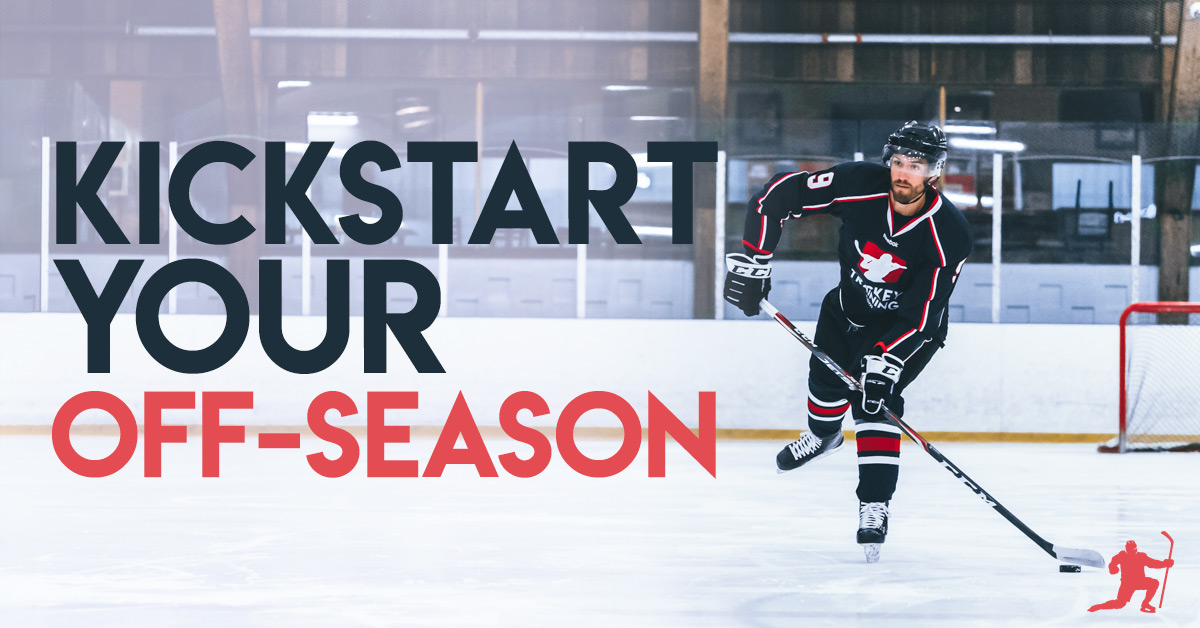
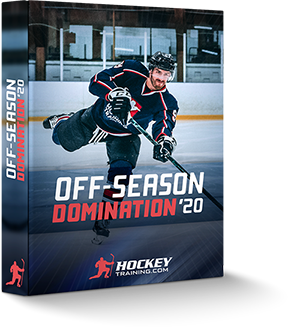

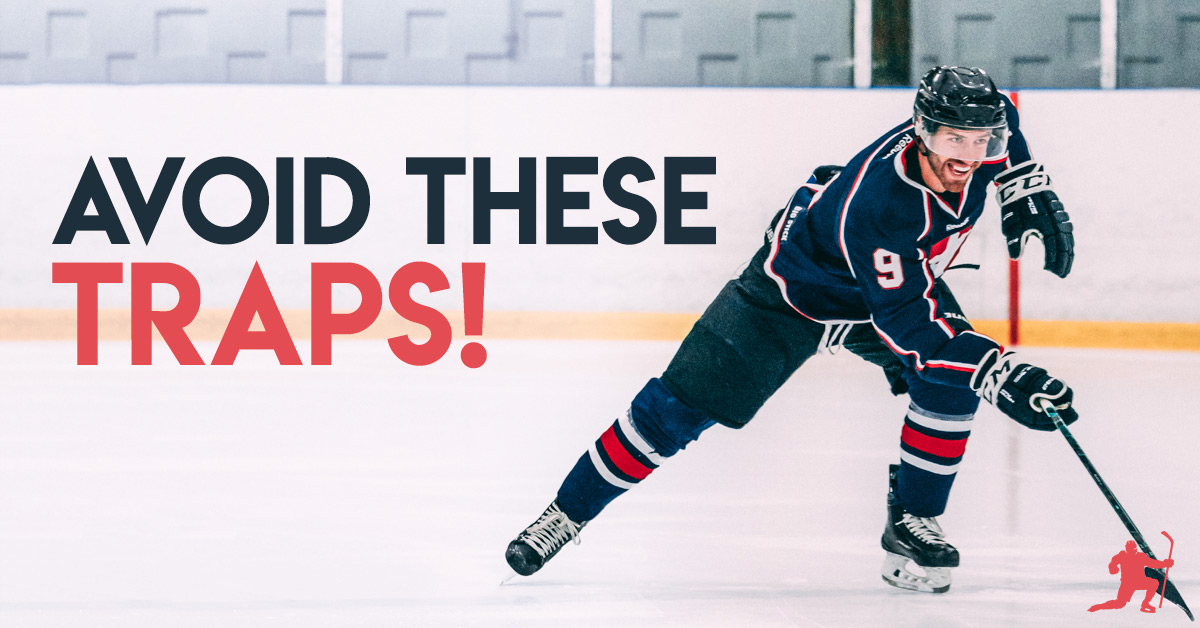



This seems to be a fantastic program. I’m just not sure if I can continue to do 6 workouts per week for the full next 6 month, so can this program also be scaled down to 3 or 4 workouts per week if I have to, for example for work reasons?
Hey Thomas,
Great question.
Although it “can” be scaled down to 3 workouts per week, I don’t really recommend that as the best results will come through training as often as I have prescribed in the original format.
If you are a men’s leaguer, programs that can be run 3-Days per week include the Men’s League Domination 3.0 and the Men’s League Annihilation system (you can find them both here: http://www.hockeytraining.com/programs)
If you were to join the team on the Off-Season Domination program, I would recommend you run it as it is originally prescribed and then if you run into a scheduling issue you could contact me directly and we would figure out a revised schedule for you to perform during that time.
Hope this helps! 💪